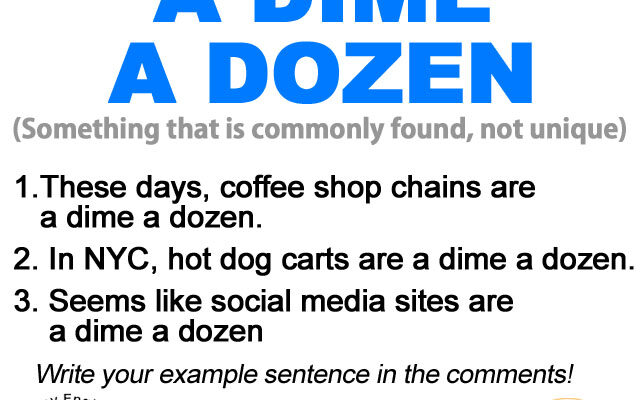In the vast ocean of idioms that enrich the English language, the phrase “a dime a dozen” stands out for its colorful history and utility. While it may conjure images of loose change, this expression offers much more than a monetary metaphor.
- The Origins of “A Dime a Dozen”
- What Does “A Dime a Dozen” Really Mean?
- Everyday Examples
- How to Use “A Dime a Dozen” Effectively
- Tips for Usage
- Why Do Idioms Like “A Dime a Dozen” Persist?
- Universal Appeal
- The Art of Brevity
- Modern Applications and Adaptations
- Digital Content
- Social Media
- Economic Discussions
- Conclusion
The Origins of “A Dime a Dozen”
The phrase “a dime a dozen” dates back to the early 19th century in the United States. During that era, a dime was a significant coin, and many common goods, such as eggs and apples, could be bought for a dozen per dime. This affordability and abundance cemented the phrase in the American lexicon as a way to describe something plentiful and inexpensive.

What Does “A Dime a Dozen” Really Mean?
At its core, “a dime a dozen” suggests that an item or concept is so common that it holds little intrinsic value. In essence, it implies that the subject is not unique and is easily replaceable. This can be applied to physical goods, ideas, or even people in certain contexts.
Everyday Examples
- Products: “In todays market, basic smartphone models are a dime a dozen, with little to set them apart from one another.”
- Ideas: “In the tech world, new app ideas are a dime a dozen, but execution is what truly matters.”
- Skills: “In the job market, general administrative skills can be a dime a dozen, but specialized expertise is rare and valuable.”
How to Use “A Dime a Dozen” Effectively
Using this idiom effectively requires understanding its context and connotations. It is best employed when you want to emphasize the lack of uniqueness or value in something that is readily available. However, its important to use it judiciously to avoid devaluing someone or something unnecessarily.
Tips for Usage
- Be Specific: Clearly identify what you are referring to as common or abundant.
- Consider Tone: Ensure the context is appropriate, as the phrase can carry a dismissive tone.
- Context is Key: Use in situations where the abundance directly affects perceived value.
The phrase “a dime a dozen” serves as a linguistic tool to convey the abundance and commonality of certain items, ideas, or skills. By understanding its origins and nuances, you can incorporate this idiom into your communication effectively, adding both clarity and color to your language.
So next time youre faced with an array of options that seem indistinguishable, remember this phrase. Its as common as the subjects it describes, yet its proper use can add a hint of sophistication to your expression.
Language, much like fashion, is cyclical and ever-evolving. Yet, certain idioms, such as “a dime a dozen,” withstand the test of time. Perhaps its because they encapsulate universal truths in a way thats accessible and relatable to generations past and present. Lets delve deeper into why such expressions continue to resonate and how they can be adapted to modern-day language.
Why Do Idioms Like “A Dime a Dozen” Persist?
The enduring nature of idioms can often be attributed to their ability to simplify complex ideas into digestible concepts. “A dime a dozen” distills the notion of oversupply and diminished value into a succinct, memorable phrase.
Universal Appeal
Idioms like this one thrive because they tap into shared human experiences, transcending cultural and temporal boundaries. The idea of something being commonplace is easily understood, whether you’re in a bustling metropolis or a quiet village.
The Art of Brevity
In a world increasingly driven by rapid communication and soundbites, brevity is key. Idioms offer a shorthand to convey complex ideas without lengthy explanations. In the case of “a dime a dozen,” the listener immediately grasps the essence of abundance and commonality.
Modern Applications and Adaptations
While rooted in history, idioms can be refreshed to fit contemporary contexts. “A dime a dozen” can find a place in discussions about digital content, social media trends, or even economic debates.
Digital Content
In the age of information overload, where blogs and vlogs proliferate, certain content can be considered a dime a dozen. The challenge lies in creating content that stands out amid the noise.
Social Media
Trends on platforms like Instagram or TikTok often become a dime a dozen as they are quickly replicated. Originality is the currency that breaks through the monotony.
Economic Discussions
In economic terms, goods or services that were once scarce but have become ubiquitous can be described as a dime a dozen, highlighting shifts in market dynamics.
Conclusion
Idioms like “a dime a dozen” remain relevant because they encapsulate universal truths in a succinct and relatable manner. Their adaptability to modern contexts ensures their place in our evolving linguistic landscape. Whether you’re crafting digital content or engaging in a lively debate, this idiom can add depth and color to your communication.
So, the next time you encounter something that seems overly abundant, consider how this age-old phrase can articulate your thoughts with precision and flair. After all, in the world of language, some expressions are too valuable to be a dime a dozen.


The historical context adds so much depth to my understanding of the phrase. I’ll definitely be more mindful when I use it now.
This article provides a fascinating insight into the origins of the phrase “a dime a dozen.” I had no idea it dated back to the 19th century!
The everyday examples provided really help in understanding how common things can be described using this idiom. Great read!
I found the tips for usage particularly helpful. It’s important to consider context and tone when using idioms like this.
I appreciate how the article explains not just the history, but also how to use “a dime a dozen” effectively. Very informative!
A well-written piece that balances history with practical advice on usage. It’s always interesting to learn about language evolution.